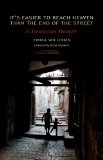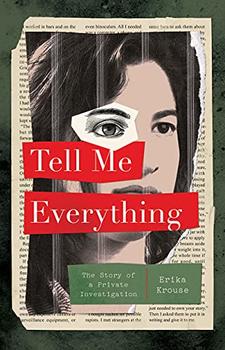Summary | Excerpt | Reviews | Beyond the Book | Read-Alikes | Genres & Themes | Author Bio

A Jerusalem Memoir
by Emma WilliamsThis article relates to It's Easier to Reach Heaven Than the End of the Street
There have long been Jewish communities in Palestine, but populations saw particularly rapid growth as Jews fled European pogroms during the 19th century. A large wave of immigration, mainly from the Russian Empire began in 1881 and continued up until the start of World War I. During this period, known as the First and Second Aliya ("ascent"), over 70,000 Jews immigrated to Israel, which was then part of the Ottoman Empire, establishing the first kibbutz and reviving Hebrew as the national language; before this wave of immigration it is estimated that Jews represented about 4% of the local population.
In 1917, with the Ottoman Empire routed and the British in control of Jerusalem, British Foreign Secretary Arthur Balfour wrote a letter to Baron Rothschild, a leader of the British Jewish community. This letter, written in response to long standing political pressure, has become known as the Balfour Declaration. It laid the groundwork for the establishment of a national home for the Jewish people in Palestine.
The letter said in part that the British government "view[ed] with favour the establishment in Palestine of a national home for the Jewish people, and will use their best endeavours to facilitate the achievement of this object, it being clearly understood that nothing shall be done which may prejudice the civil and religious rights of existing non-Jewish communities in Palestine, or the rights and political status enjoyed by Jews in any other country." The League of Nations backed the plan, granting the UK a mandate over Palestine in 1922. At the time, the area's population was predominantly Arab and Muslim, with Jews accounting for approximately 11% of the population.
In the decade starting from 1929 Jews began streaming into Palestine in an attempt to escape Hitler's war machine; and by the end of WWII they accounted for a third of the area's population. Resident Arabs complained to the British, who responded by capping immigration. This did nothing to lessen the tensions between the Arabs and the Jews, and in fact caused increased resentment of the British on both sides, with the Arab population feeling the British weren't being restrictive enough, while the Jews felt they were not allowing in as many Jewish refugees as they should. Armed skirmishes resulted, with Arabs and Jews attacking each other and both attacking the British.
In 1947 the British government withdrew from Palestine, stating that it was unable to devise a solution acceptable to both sides of the conflict. The newly-created United Nations devised a partition plan which divided the country into two states, one Arab and one Jewish. The Jewish community accepted the plan, but the Arab League (a regional organization of Arab states) did not. Civil war broke out, with the Jews ultimately gaining the upper hand. A pattern of attack and reprisal occurred, with an estimated 250,000 Palestinian Arabs fleeing or being expelled from their homes.
Israel declared its independence on May 14, 1948. The following day the armies of five Arab countries attacked, launching the Arab-Israeli War. By the end of 1948, about 650,000-750,000 Palestinian Arabs, approximately 80% of the Arab inhabitants, had left their homes - many of which had been occupied by their families for centuries.*
There is a great deal of contention around the reasons for the exodus. Palestinian supporters cite deliberate violence against the Arab population, including massacres at Deir Yassin and Tantura. The pro-Israelis, on the other hand, claim the Arab leadership exaggerated the violence being inflicted by the Israeli militia, and this propaganda campaign encouraged the Palestinians to abandon their homes. Regardless, by the end of 1948, over 400 Palestinian towns and villages were cleared, most were completely destroyed. Palestinians who had fled or been expelled were not permitted to return after an armistice in 1949, and Israeli settlers confiscated the homes and property of the displaced Palestinians.
The status of the refugees, and in particular whether or not they have the right to return to their homes or be compensated for their loss of property, remains one of the key issues in the ongoing Israeli-Palestinian conflict. It is difficult to get an accurate count of current Palestinian refugees and their descendants, but most agree the number is over 7 million worldwide.
The Israelis celebrate their independence with a national holiday, Yom Ha'atzmaut, every May 14. The Palestinians observe May 15 as Al-Nakba (the catastrophe) - an annual day of mourning and protest.
*Readers may be interested to note that in the twenty years following 1949 it is estimated that about 850,000 Jews (almost the entire Jewish population) abandoned their homes in the Arab world - some by choice, but most due to persecution or active expulsion; the majority relocated to Israel.
Filed under Society and Politics
![]() This article relates to It's Easier to Reach Heaven Than the End of the Street.
It first ran in the July 8, 2010
issue of BookBrowse Recommends.
This article relates to It's Easier to Reach Heaven Than the End of the Street.
It first ran in the July 8, 2010
issue of BookBrowse Recommends.




It is among the commonplaces of education that we often first cut off the living root and then try to replace its ...
Click Here to find out who said this, as well as discovering other famous literary quotes!
Your guide toexceptional books
BookBrowse seeks out and recommends the best in contemporary fiction and nonfiction—books that not only engage and entertain but also deepen our understanding of ourselves and the world around us.